Conquistadors of the Useless (58 page)
Read Conquistadors of the Useless Online
Authors: Geoffrey Sutton Lionel Terray David Roberts
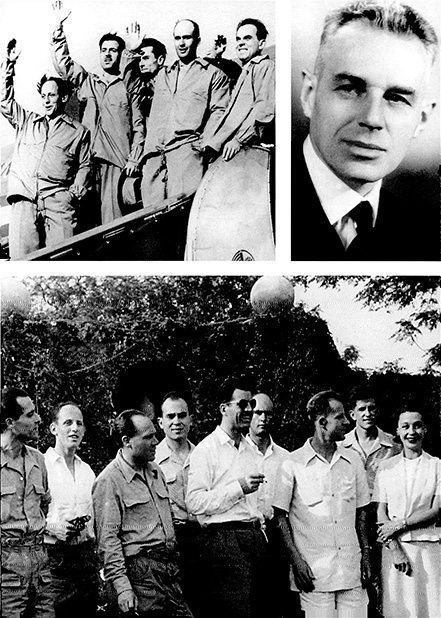
Annapurna 1950. The lack of pre-war French activity in high-altitude mountaineering led to a resolve to play a more active role in the post-war years. With Nepal newly accessible, permission was gained in 1949 to attempt either Dhaulagiri or Annapurna. An expedition was rapidly organised and financed, an effort in which the veteran mountaineer Lucien Devies (left) played a key role. The party, led by Maurice Herzog (right) set out for Nepal in early April.
Bottom: The Annapurna expedition members at a press conference and reception at the French Embassy in New Delhi with (left to right) Jean Couzy, Louis Lachenal, Jacques Odot, Marcel Schatz, Maurice Herzog, Lionel Terray, Francis de Noyelle, Gaston Rébuffat and Madame Levi, the ambassador's wife.
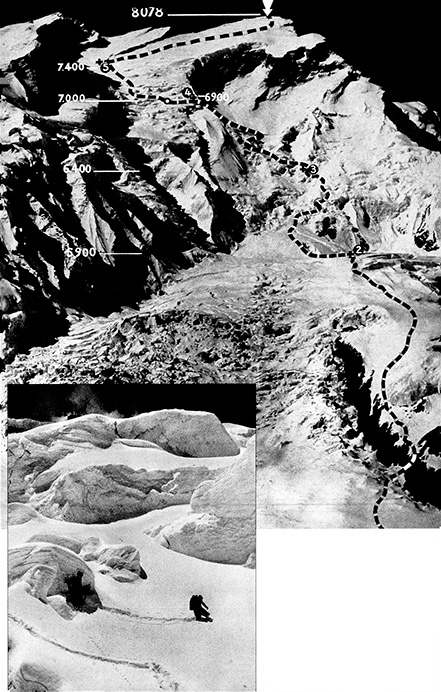
Top: The northern glacial slopes of Annapurna (foreshortened) with the 1950 route and camps marked. Camp 4 was initially sited in the basin before the Sickle.
Bottom: Negotiating the avalanche- and sérac-menaced slopes between camps 2 and 3.
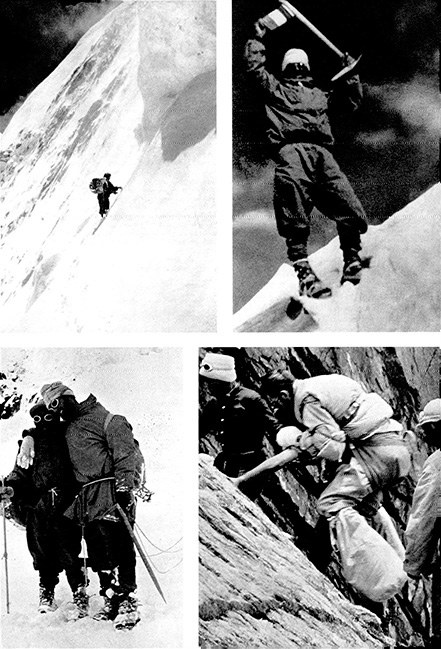
Top left: Steep climbing around the base of the Sickle (the curving rock and ice cliff) to reach the repositioned Camp 4.
Top right: On the summit of Annapurna.
Bottom left: Terray, snowblind, returns to Camp 2.
Bottom right: The frostbitten Herzog is carried down the rocks below Camp 1.
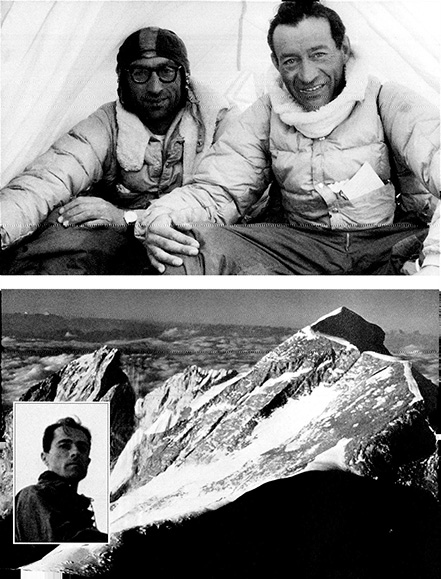
Top: Makalu 1954-44 Lucien Devies was again to the fore in organising the French attempt on the world's fifth-highest peak. Annapurna veterans Terray and Couzy were joined by Jean Franco (leader), Guido Magnone and others. A reconnaissance trip (with the Kangchungste and Chomo Lönzo) prepared the way for success in 1955 with nine climbers reaching the summit.
Bottom: Chomo Lönzo (25,640 feet) seen from Kangchungste (25,120 feet). Terray and Couzy
(inset)
made the first ascent by the obvious curving ridge.
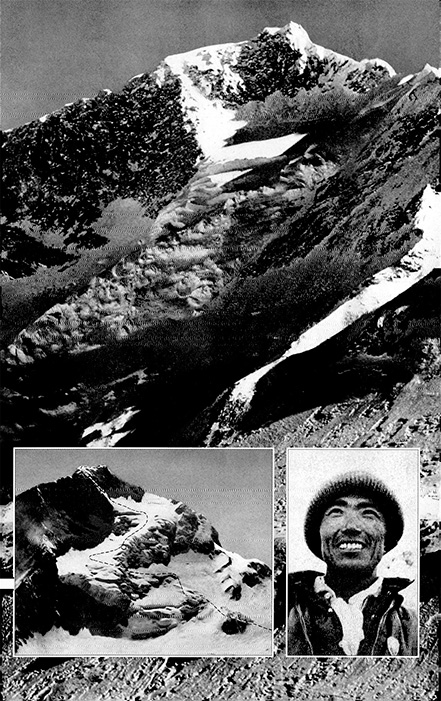
Kangchungste also gave a view of the northern slopes of Makalu. The route taken in 1955 is marked on a photo taken from Chomo Lönzo
(inset left)
. Gyaltsen Norbu
(inset right)
who in 1956 added Mansalu to his Makalu ascent, becoming the first person to climb two 8,000-metre peaks.
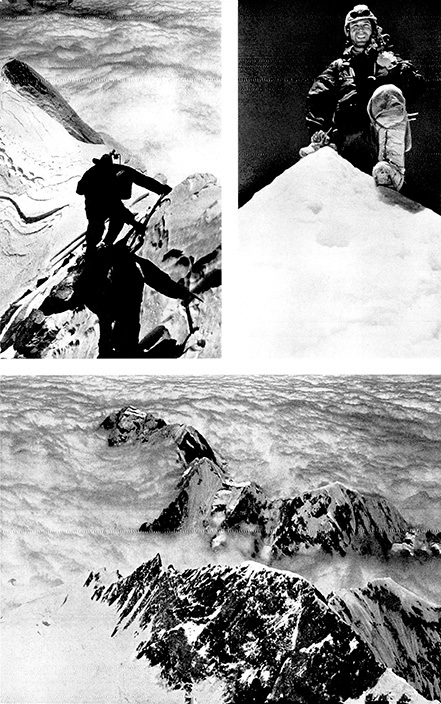
Top: Jean Couzy on the final climb to gain the summit of Makalu (27,790 feet).
Bottom: The view from the summit down to the south-east ridge (climbed by a Japanese expedition in 1970) and eastern cwm of Makalu with the Chamlang massif in the background.
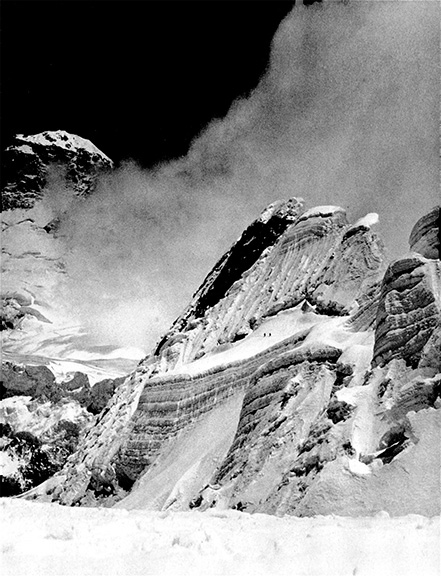
Jannu 1959-62. After the unexpected ease of the ascent of Makalu, Jannu (25,294 feet) was selected by the French (Devies, Franco, Terray etc) as their next objective. Here was a Himalayan peak offering difficulties the befitted the skills of the now very experienced team. This impression was confirmed as, even by its easiest route, Jannu is defended by a myriad of difficulties and dangers.One of the main obstacles was the ice-encrusted Tête du Butoir (pictured) which was chosen in 1962 as the safest (though hard) route of ascent to the higher levels of the mountain.
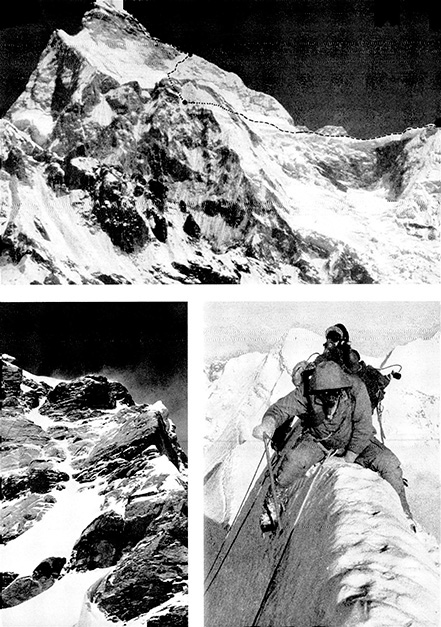
Top: From Buffer Peak (extreme right) the route skirted below the ice pinnacles of Tête de la Dentelle and traversed into the main upper cwm of the mountain (the Throne). From here the ridge was regained to where Camp 6 was placed as a base for the summit push.
Bottom: A snow couloir
(left)
breaches the summit fortress to gain the near-level extended final arête. In places this was so sharp that à cheval techniques were needed to pass safely
(right)
. Oxygen and fixed ropes assisted the ascent. The route to the summit arête was repeated in 1978 (in alpine style) by Alan Rouse, Rab Carrington, Roger Baxter-Jones and Brian Hall.

Fitzroy 1952. Top: At base camp: René Ferlet (left), Louis Dépasse, Lionel Terray, Marc Azéma, Guido Magnone, Franciso Ibañez and Louis Liboutry. Photo: George Strouvé.
Bottom left: Count Aldo Bonacossa's 1937 expedition reached the snow col (on the left) below Fitroy's south-east buttress and the 1952 team chose the same route.
Bottom right: A key to success were the snow caves dug for Camp 1 and Camp 3 (on the highest snow field). These enabled the team to sit out the frequent storms and work on the rock bastions above during calm spells.
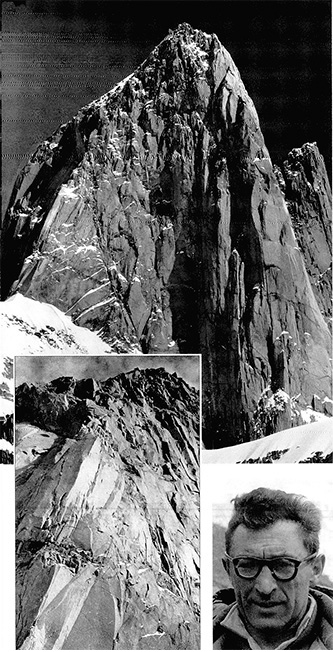
Top: Fitzroy's south-east face with the French route on the left, the slabby rib. In 1984 Miguel Angel and J.L. Garcia-Gallego climbed the face to its right (roughly the line of the light and shade). The 5,000-foot east buttress (centre right) fell to Casimiro Ferrari and Vittorio Meles (1977) who finished the 1974 work of the Swiss.
Photo: Dave Nicol
.
Bottom left: Granite slabs at the start of the 1952 route. The obvious diagonal crack slanting right from the centre/base of the photo gained the broken cliffs above.
Bottom right: Guido Magnone, whose rock-climbing skills proved crucial on Fitzroy. A few months later Magnone (with three others) made the first ascent of the west face of the Dru and, later, Mustagh Tower, Makalu, Jannu and Chacraraju Este.